Google’s People Also Search For 2022 Guide
Google is a powerhouse that offers many power tools at our disposal. ‘People also search for’ is one of those indispensable SERP features that are both free and easy to use. Mind you, PASF wasn’t necessarily created for our purposes, although our use for it didn’t go unrecognized by its creators.
Google’s number one client is their everyday user – not businesses. Hence their focus on creating an organic search engine that highlights content that the user will find valuable based on their query – not one that drives traffic to the highest bidder.
When you search anything on Google, at the bottom of the page are up to eight related search terms that help users find what they’re looking for. It’s a resource that allows us to dive deeper into our search with the intention to drive us towards what we’re searching for.
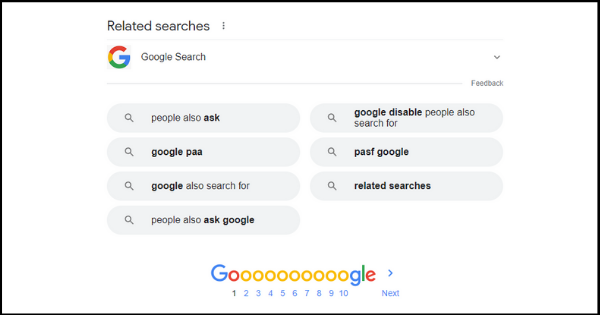

How This People Also Search For Guide Aims to Help
Take a look at the image above. When we entered ‘People also search for’ into Google, these are the related search terms it laid out for us.
The related searches are:
1. people also ask
2. google paa (People also ask)
3. google also search for
4. people also ask google
5. google disable people also search for
6. pasf google
7. related searches
Notice how similar all these terms are. Some are the exact same keyword just written in a different way. That’s because people have entered those terms into Google but are all ultimately looking for the same thing.
Also notice results #1 and #2. These are not the same search terms, but they are very relevant – we’ll touch more on PAA boxes below.
So now the question is, what do you do with these terms and how do they allow you to be more strategic with your content approach.
This Google People Also Search For 2022 Guide includes a step-by-step strategy along with a free Google sheet that will allow you to organize your data for every piece of content for your website. Our aim is to provide you with the know-how you need to get you to the first page of Google and increase traffic to your website.
Diving into Google Related Searches
Now that we’ve talked about where to find these related keywords searched on Google,
let’s dive into the how and the why from a strategic perspective.
How to Use PASF Google Search Terms
Google related searches are key to understanding what your user is looking for and how you can place your site at the forefront of these inquiries. For this study, we’re going to use the search term ‘the marketing agency‘.
KW Planning
When we search for ‘the marketing agency’ this is the first result we see on the first page:
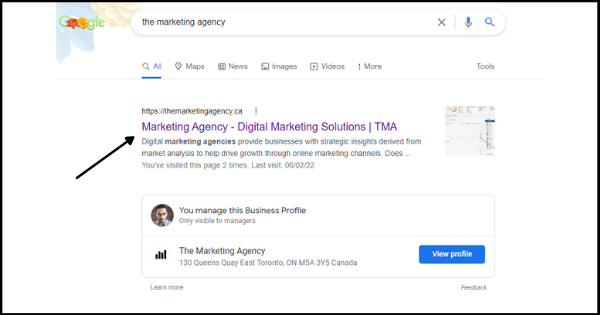

Woohoo for us, but that’s beside the point.
When we scroll down to the bottom of the page, we find our related searches.
There, we have search terms like digital marketing agency toronto and marketing agencies toronto.
We’ll be using these related searches when creating our piece of content. We now know that people who are looking for ‘the marketing agency’ may also be looking for ‘digital marketing agency toronto’.
User Intentions
If people also search for keywords containing the word ‘toronto’ this now localizes the intent of our original term. Now we know that the intent of this term is fixed to a specific location.
Well, where this term was searched from also makes a big difference. I’m writing this from Toronto, Canada – so, my search results are geo focused. But alas, that just means that if I were in New York City, my related searches would be localized to that city. So instead of seeing ‘toronto’ as an extension of that keyword, you’ll likely see your city at the tail end of that query.
Still – that just means that I may have to create multiple pages directed at multiple cities. But for simplicity’s sake, let’s narrow down our focus for this study.
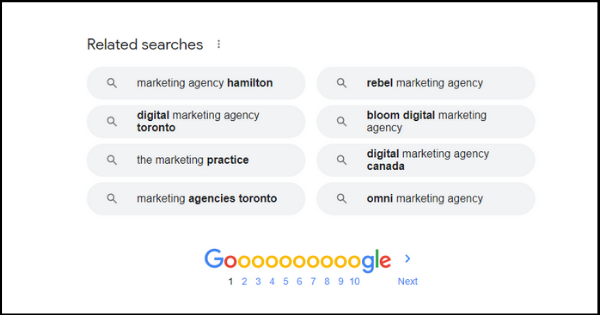

Content Creation
Knowing what we know now – I may create multiple blogs with different cities as my focus. For example:
Topic #1: Why The Marketing Agency in Toronto is Your Go-To for Search Marketing
Topic #2: How The Marketing Agency in New York City Can Help Boost Your Rankings
Topic #3: The Latest Case Study from The Marketing Agency in Miami
Essentially, all of these blogs will carry similar content – not duplicate content – that’s geo-targeted and allows us to rank for different locations.
So now that we’ve covered the basics – let’s run you through the nitty-gritty details. Don’t forget to click below for your free Google Sheet which will allow you to organize your data with each blog.
Having an organized content planner will ensure that you don’t cannibalize your keywords. Keyword cannibalization means competing against yourself for the same keyword across multiple pages. This can make Google skip past indexing your page and ultimately make you lose out on gaining the traction you were looking for.
Let’s jump into it.
Extended Related Searches
At the risk of skipping ahead a few beats, let’s touch on extended related searches. You’ll find certain keywords bring up more than your usual related Google search terms at the bottom of your results page. The below image is what came up from a keyword we’re going to touch on below: types of apples.
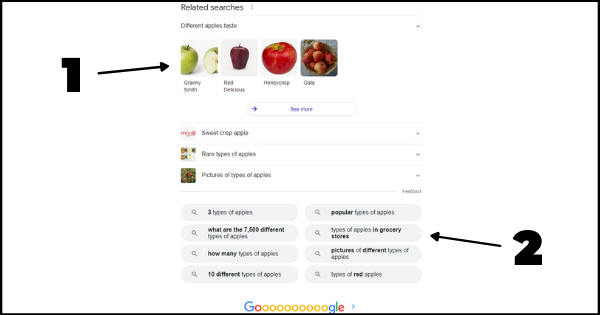

Can you guess why Google responded to this search term differently? Is it…
a) More pictures are an indication that users have shown more interest in images when it comes to this search term
b) More images means the term requires a visual explanation
The correct answer is a, but also kind of b.
If the term requires a visual interpretation, then more users are likely to click on image-related results. This leads to Google understanding the user intent as image-related and hence offering visual results.
Google is attempting to – and succeeding in – staying two steps ahead of its users by predicting where they will go next more efficiently. By studying what their previous users have done with this search term, Google is able to predict our next moves.
Google didn’t respond the same way to ‘the marketing agency’ because there’s no visual representation that would encompass that term. Instead, the search engine may offer up something more related, such as a map.
People Also Searched For Step by Step Strategy (with Pictures and Free Google Sheet)
Before we jump in, open up our free People Also Search For Strategy Sheet and make a copy. This will allow you to make changes and add in your own data.
Once that’s done, you’re ready to go!
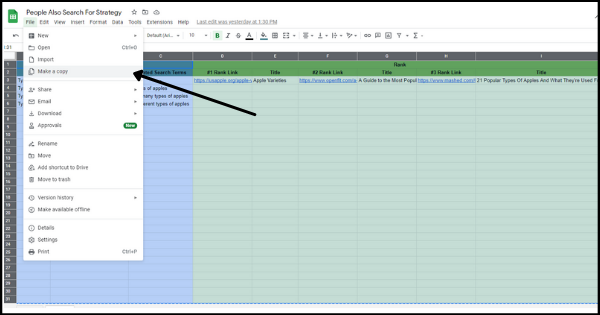

1. Narrow down the topic
When choosing your topic, think of different ways it can be searched. Jot down 5 to 10 variations of your keyword. If you’re a local brand don’t be afraid of using geo-targeted terms, but don’t include local search terms like ‘near me’.
Take your time with this step, consider asking those around you how they would word it as well. How and what people search for on Google will differ from person to person, but if it’s prominent enough, the search engine giant will take notice and so should you.
For this example, we’re going to choose the keyword ‘types of apples‘ From there we gathered ten different variations:
1. types of apples
2. different types of apples
3. kinds of apples
4. types of apples chart
5. types of red apples
6. types of green apples
7. all types of apples
Don’t forget about your long-tail keywords – those are longer keywords put in sentence form. For example:
8. how many types of apples are there
9. what are the different types of apples
10. how many different types of apples are there
2. Insert Your Keywords into Google Search
Start with your first keyword, enter it into your PASF Google Sheet in rows 3 to 6 under column B and then insert it into Google.
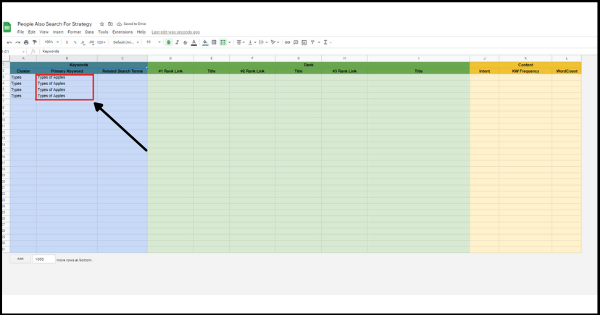

Take note of your first 3 results, extract the link and title and place them into your PASF Strategy Google Sheet to fill out columns D to I.
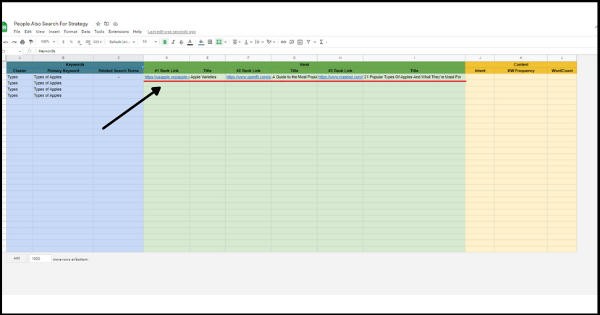

When we scroll down the results page, these are the related searches that come up:
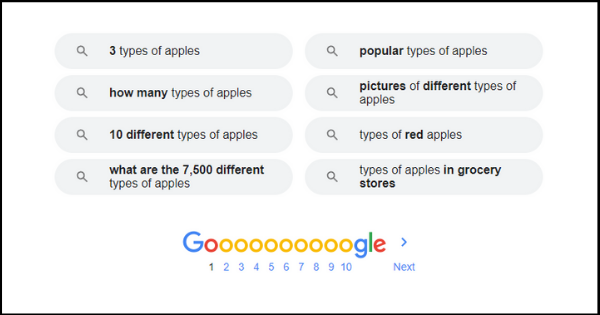

Pick three of those related search terms and open them in a new tab. Repeat the above steps for each – keeping the ‘primary keyword’ the same for each of these related search terms.
This allows us to keep track of ‘clusters’ – a group of related keywords we can use in one piece of content. Using these clusters together in one or a few connected blogs will help each other rank due to the close relation of the topic.
To keep track of these clusters – give them the same cluster name that defines the topic. Typically this will be derived from the primary keyword.
For example, for our first keyword, ‘types of apples’, our cluster name is ‘types’
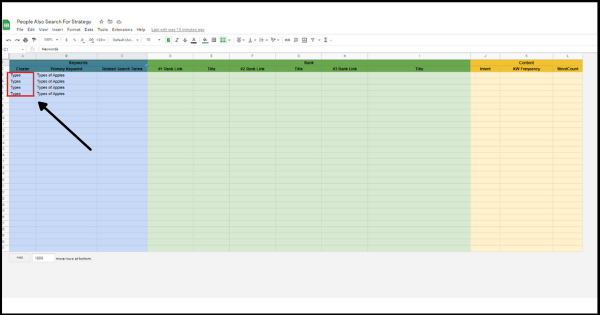

Repeat the above steps for each of the three related search terms that you gathered from the ‘people also searched for‘ section and then move on to the next step below.
3. Study each New Tab
By now, you likely have 4 tabs open for each keyword. One for your original, primary, keyword, and 3 related search terms you opened up.
From there, you’ve also opened up the first three results of each term. From those results, we want to fill out columns J – L in our People Also Search For Strategy Sheet. These are intent, keyword frequency, and word count.
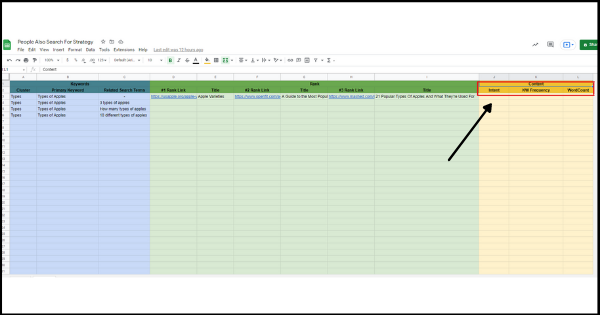

What does this information mean and how is it useful?
Intent
Understanding the intent of a user, whether it is to buy or learn – or both – is critical to creating content that appeals to them. If you create a page aimed to sell apples, when people are looking for research, you’re going to miss the mark and lose rankings because your bounce rate will increase. People are simply not finding what they’re looking for and that’s reflected in your site data.
The different options available in this J column are:
1. TOFu (Top of Funnel – a.k.a a landing page that’s main focus is to sell a product or service.)
2. BOFu (Bottom of Funnel – a.k.a a piece of content that aims to inform and educate.)
3. Hybrid (A page that serves both TOFu and BOFu intents)
Choosing the right intent for your content piece ensures a higher success rate for that page to rank well on Google.
Use the drop-down in column J to choose the best option for your page.
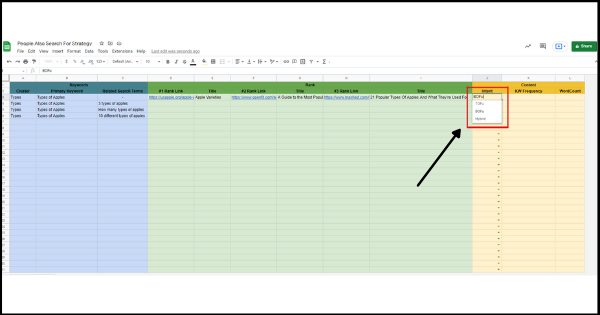

KW Frequency
When you start putting together your content, how many times should you ‘input’ your keywords? What’s the benchmark you should follow? These are both really good questions but they don’t come with a straightforward answer.
That’s because there is no magic number you should hit within your content. The key here is to use your keywords authentically without jeopardizing readership quality. If it sounds natural when you read it, then you’re on the right track – if it sounds stuffy and awkward, you should reconsider your writing.
Here’s an example using our primary keyword from above:
☒ If you like types of apples that are red, you should also try the delicious sour green kind!
☑ Many people aren’t aware of just how many different types of apples actually exist – the real number is quite overwhelmingly large.
The difference in content flow between the first and second sentences is clear. The first one seems very forced – have you ever encountered someone who really forced the use of big words in a conversation? It’s kind of like that, and sounds just as awkward when read aloud.
The second sentence flows well, and also adds value to the overarching idea of the content – which is very important. Every word written should have a purpose behind it, adds some sort of value to the main idea and leads readers into the next point.
To get an idea of what your competition is doing, use Ctrl+F or COMMAND+F to search for the primary keyword in the different results you found above.
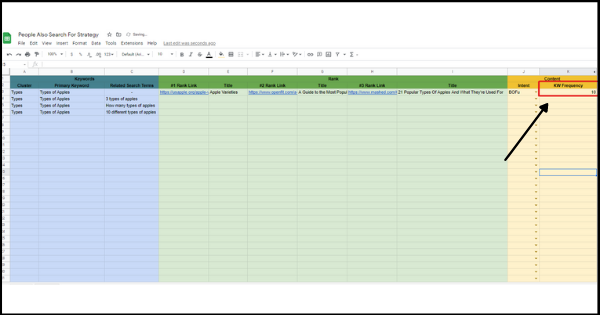

If the content flows nicely and adds value the reader can digest, you can follow a similar rule that will depend on the word count of the entire piece.
Take note of how many times the keyword appears under column K in your People Also Search For Strategy Sheet.
Wordcount
The amount of times a keyword comes up within every 100 words is something to keep in mind. This is a general rule based on readership and how the use of a keyword within your content will flow. That’s why taking note of how many words exist within these pages will be crucial to our end result.
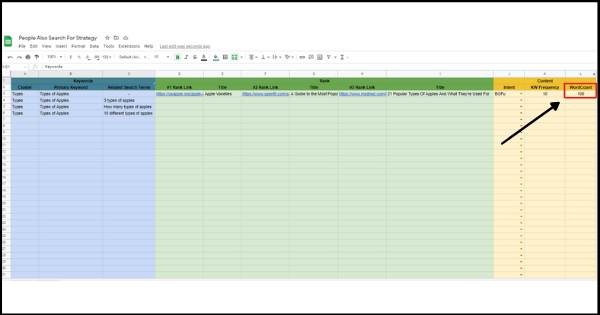

Here’s a neat and free online tool to use for word count. Copy and paste the site content into that link and take note of how many words there are under column L in your People Also Search For Strategy Sheet.
4. Keyword per 100 Words Formula
Column M in your People Also Search For Strategy Sheet will automatically update depending on your input into columns K and L.
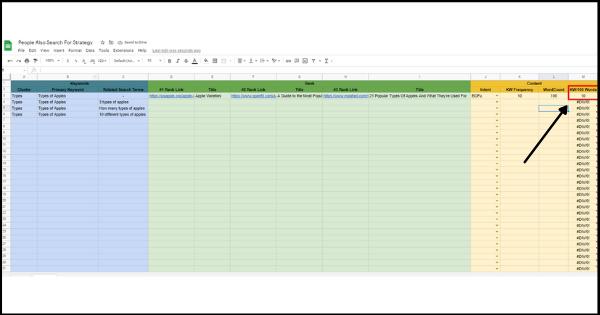

Your keywords per 100 words metric will give you a rough idea of what to strive for so long as you’re only using benchmarks with quality readership content.
With that, you should still be wary as you create your own content. Remember, if it doesn’t sound authentic, it won’t resonate with the reader.
5. Enter Your Data In Our PASF Strategy Sheet
Our free PASF Strategy sheet will allow you to organize your data and keep it handy as you continue to create new content for your website. For each new blog or landing page, duplicate your sheet as shown below. You can then erase all the existing values and create the new page as a template to be duplicated each time you start a new strategy.
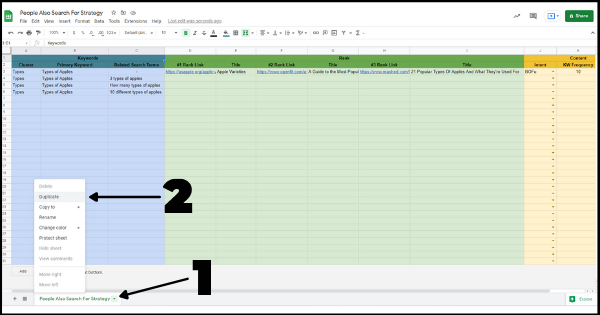

Understanding How to Use the Data
Take a few minutes to run through your data and take in how they intertwine and work together to provide you with insight into the end result – which is your strategic piece of SEO content. Now, let’s review the steps and how they fit together.
1. Narrow down the topic: Get super niche and from different perspectives. Get the input of several people on how they would search for a specific thing or service and write down up to ten different variations. These variations are different forms of the same or similar keywords that would lead to the same or a related result.
2. Insert your keywords into Google Search: These different terms will bring up the same, similar, and related results. Each set of results will provide insight into the user’s intent. In the end, you’ll have an increased awareness of how all the above search terms relate.
3. Study Each Tab: The number of times that each keyword shows up in the top three results will give you a clear idea of why these pages have achieved their rank. Understanding the purpose of each page – to sell, educate, or both – tells you a lot of the intent of the user for that group of results. If you aim to educate but the majority of results for that term is to sell – that indicates that it isn’t the space for you and you should reconsider your keywords.
4. Keywords per 100 words formula: How many times the keyword shows up in the results per 100 words will allow you to apply the same formula for your content. It’s a strategic way to go about creating content and compete with the top three results.
5. Enter your data in our PASF strategy sheet: Organizing your data provides you with a clear roadmap of how you should create your content. Achieving a rank in the top Google results for specific search terms falls on a few factors:
a) Filling user intent
b) Offering value to the user
c) Showing Google your intent and value by using key terms that relate to a and b
6. Understanding how to use the data: Of course, knowing how to use the above strategically is key to proper implementation.
Similar SERP Features
Now that you have a clear picture of how to use ‘People Also Search For‘ for strategic content creation, let’s dive into other SERP Features that you can add to your toolbox.
1. People Also Ask Boxes
2. Featured Snippet
3. Google Ads
4. Shopping Results
5. Videos
1. People Also Ask Boxes
This is another great way to reach users who are asking specific questions. They can also provide insight into the inquiries most frequented by users and give you an opportunity to answer those questions within your content.
When doing so, there are a few things to keep in mind.
1. No click-bait: Answer the question within the first sentence and provide an elaboration beyond that. Going into further detail after you’ve satisfied the user’s curiosity gives them the option to click on your link as opposed to either forcing them to click or to go elsewhere to satisfy their curiosity.
2. Keyword Insertion: If you can do it authentically and organically without jeopardizing readership, insert the keyword within the first sentence – even better, at the beginning of the sentence when possible.
3. Bolded Words: Instead of bolding the keyword here, you want to bold the answer. Choose the lowest number of possible words that can answer the question in full. Notice the answer to the question in the image below – the bolded words are a perfect example of this technique.
4. The Question is Your Header: Insert your question as the header of your content.
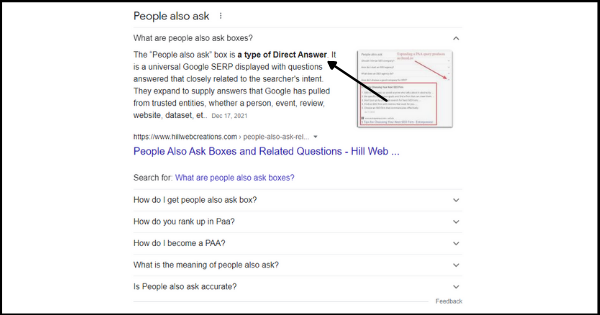

2. Featured Snippet
Featured snippets are direct answers to a query that offer instant answers in the quickest way possible. Attempting to take the spot of a featured snippet will require similar techniques to that of the people also ask boxes.
Include the keyword at the beginning of the sentence and answer the question in the shortest most coherent way possible.
When creating your content, you’ll want to use the exact keyword or question as your header and have the answer below it.
Offering value is key – don’t derail from the subject and stick to giving users what they’re looking for.
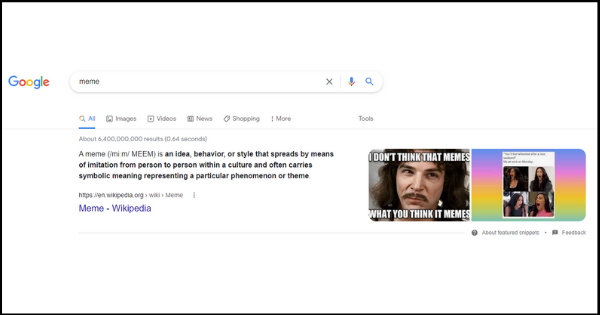

3. Google Ads
Any search term that is being targeted with ads will showcase them at the top of the search results. Ads should not deter you from organically ranking for a keyword and will always state they are an ad as shown below.
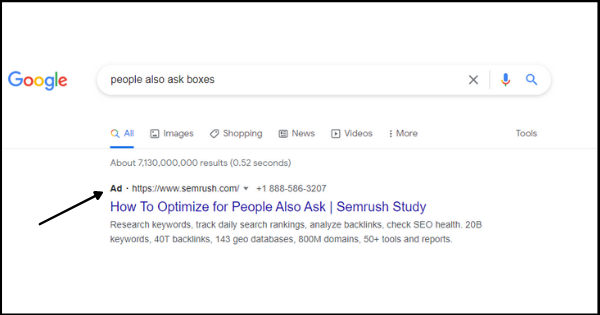

4. Shopping Results
eCommerce shopping ads will pop up at the top of the results page if your keyword is best associated with seller pages. This is a clear indicator of bottom of funnel (BOFu) intent we covered above. If your intention is to sell a product or service, and you notice these types of ads show up in the results, then you may be in the right place.
That doesn’t necessarily mean that all users are looking to buy using these keywords, so be sure to follow the People Also Search For Strategy Sheet steps we covered earlier to confirm your findings.
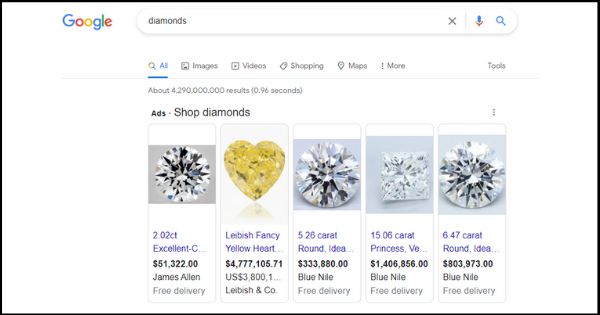

5. Videos
Video content is very powerful – it’s the preferred method of information gathering for the majority of users. The reason here is simple – videos are easy to digest and you can multitask while listening to a video so it’s efficient.
When creating video content, you need to make it even easier for your users to digest your content. That means providing time stamp links and conducting SEO best practices in the backend with the use of keyword research to help you rank. Click-bait is a no-no here as well – click-bait is a no-no pretty much everywhere.
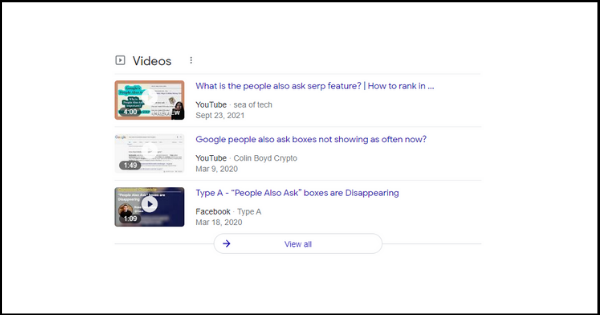

Answering Your Top Questions
How to See what People are Searching for on Google
Go to trends.google.com and open the menu at the top left hand corner. Click 'Trending Searches' to see what's trending and choose the geographical region of interest at the top right.
This will give you a good idea of what the current top searches are using Google Trends.
Daily Search Trends: This is where you'll see the top searches by day. You can change the region of your trends by choosing a new location at the top right hand corner.
Realtime Search Trends: This is where you'll find the top searches in real time. Click on a result for an hourly graph and related news.
Can You Disable People Also Search For?
Google doesn't currently provide an option to turn off PASF results. There are 3rd party chrome extensions, not tested by The Marketing Agency, that claim to make the omission.
What are Google Related Searches?
Google related searches are other search terms that are similar to, a paraphrase of, or related to your original search. They are generally populated at the bottom of a results page with up to 8 related searches. Scroll up to read an in depth guide (with pictures!) on how you can use the 'people also searched for' section for strategic content creation.
How Do You Rank Up in PAA?
In order to rank in PAA boxes you must answer the question directly, within the first sentence and use the related keyword within it in an authentic way. Remember, authenticity and value trumps all when it comes to content creation. For a more in depth look into paa boxes, scroll up for a breakdown of steps to take and what to include in your answer.
Where do Google Suggestions Come From?
Real searches, trending searches, and relevant searches that also take into account your geo location and search history. It's no surprise that Google runs on data - its autosuggestions are no exception to that rule.
What is People Also Ask Box?
The people also ask box is a set of questions related to your search. Google has found others who made the same search as you to be interested in the questions it lays out in the PAA boxes.
What Does Breakout Mean on Google Trends?
The search term grew above 5000% when you find 'Breakout' instead of a percentage next to it.
Are you among the 60% of marketers using webinars to expand their reach and boost their sales? If you aren’t then I have no idea why you’re letting these increased leads and attainable sales pass you by.
Having a website for your business is obviously essential if you plan on making any money with it. If you don’t have some sort of online presence what are you even doing reading this, start making some profiles ASAP.
When it comes to engaging with customers, one of the best ways to achieve that goal is through email marketing. If a person has signed up to receive your newsletter, then you can be assured that they want to hear from you.

